Just last year, I had taken a photo of the flowers left on 8 May in memory of Colonel Charles B. King.
Now this year, I’ve noticed the plaque in front is gone. I will notify the office in charge of this.
Pension Sprachschule Maria Shipley
A place to find teachers and books for learning - for more information about this website click on the "About" links
Just last year, I had taken a photo of the flowers left on 8 May in memory of Colonel Charles B. King.
Now this year, I’ve noticed the plaque in front is gone. I will notify the office in charge of this.
The Memorial, located behind the Hospital Church in Oberursel, is the place of remembrance for the victims of the German Nazi regime. In 2007, the project was started with the center block and the first figure.
In May 2018, the memorial was completed with the addition of two extra sculptures, the name board, and benches.
To me, this memorial is a symbol of tranquillity and reflection, and it represents the time of terror, horror, and atrocities by the Nazi regime.
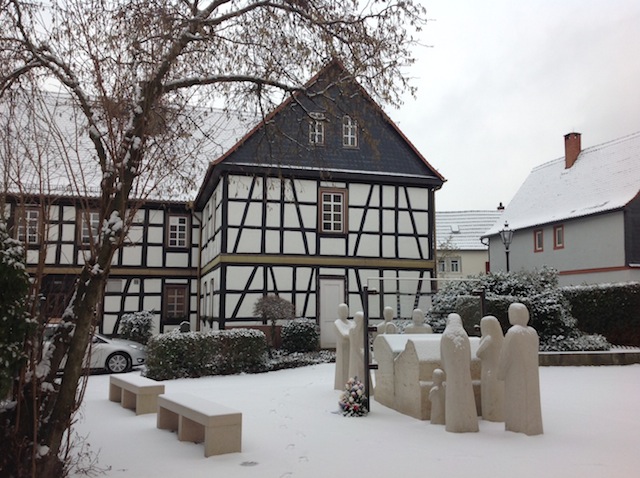
Memorial for the victims of the Nazi Germany
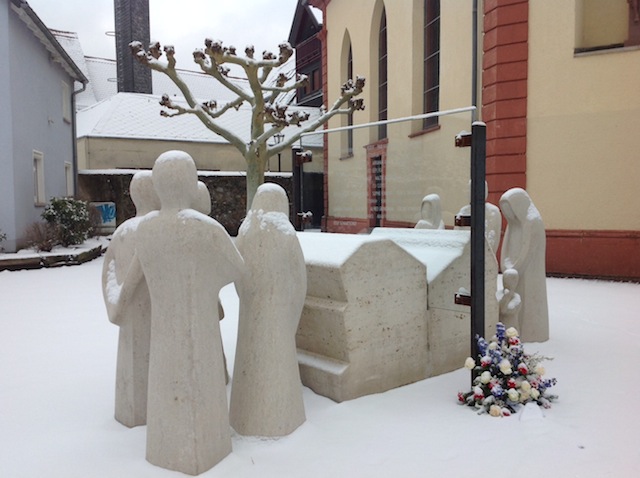
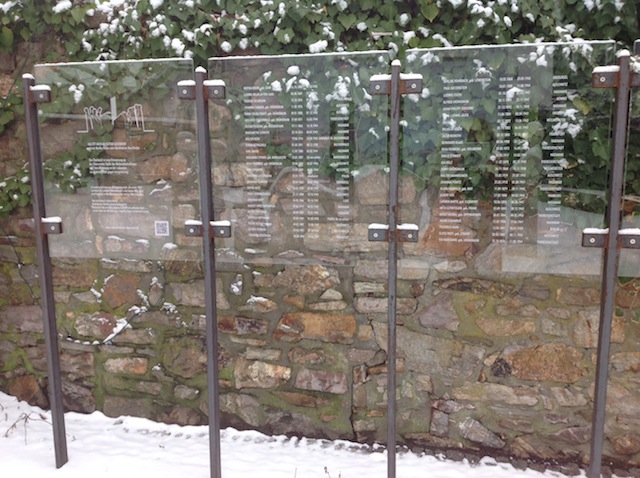
I remember my father (born 1922) telling me a story, one of denunciation among village farmers.
A farmer in the village of Maibach (northern Bavaria) informed the SS of a neighbor’s unlawful listening to the enemy radio station. This claim was not true, and only said, because he was envious of his neighbor’s properties.
The SS came to pick up that wrongly accused neighbor, and he was never seen again.
Invitation to a district-wide memorial service to observe the 80th anniversary of the pogroms of November 1938
On Friday, 9 November 2018, in front of city hall in Oberursel (Taunus), a service will be held to memorialize the Jewish population of the Hochtaunus who were victims of the pogroms of November 1938.
14:00 General information about the memorial activities for Jewish victims of Nazi persecution in the Hochtaunus
14:30 Beginning of the Hour of Remembrance
15:30 Walk to the monument dedicated to the Jewish residents of Oberursel who were victims of National Socialism
16:00 End of service
If you plan to attend, then sign up with one of the contacts listed below .

This is organized by the Gesellschaft für Christlich-Jüdische Zusammenarbeit Hochtaunus e.V. (GCJZ Hochtaunus) in cooperation with the Hochtaunuskreis.
This afternoon, we drove for about 20 minuten to the Kolbenberg Mountain, which is part of the Taunus Mountain region and the Taunus Nature Park. It borders the towns of Oberursel to the southeast, Schmitten to the northwest, and Bad Homburg to the southeast.
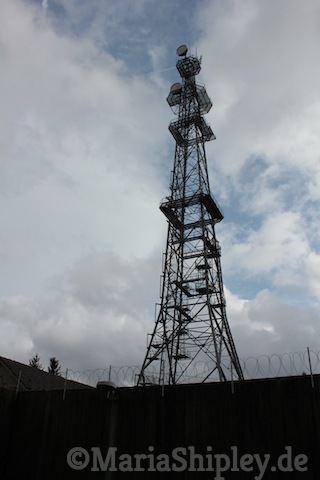
Radio Relay Site Kolbenberg, Germany
The Kolbenberg is about 690m in height, compared to the Feldberg with 890m.
The reason for this trip was one of my blog readers, who had the following question: Could you tell me the name of the of the small U.S. Air Force station above Camp King. We would go up there to their enlisted club to watch the American (military) TV channel that we didn’t have on Camp King. I remember a few soldiers talking about using the Air Force station to call home using their radio system.
On the summit of the Kolbenberg, there is a large telecommunication system with a visible lattice mast, which was used by the U.S. Air Force until 2007. Since the withdrawal of the U.S. military, the mast has been used by civilian radio services, including mobile radio.

Barbwire around the Kolbenberg Radio Relay Site
Far into the 1950s, there was also a ground radar station for the MGM-1 Matador (Matador Missile), which was a radio-controlled cruise missile stationed in West Germany during the Cold War. In the event of a launch, the missile was remote-controlled by ground-mounted radar stations, such as the one on the Kolbenberg.
The plant was rebuilt and expanded over the years. In 1962, the lattice mast was finished. At first it was painted red and white. The lattice mast is about 100 m high and can be seen clearly from far away. Since that time, the system was only used as a radio relay site. At peak times, 20 to 25 antennas were mounted on the lattice mast, often called “dishes” by the American soldiers because they looked like soup bowls.
From the station, signals were sent northwards to Obernkirchen / Schwarzenborn, east to the Wasserkuppe and southeast to Breitsol / Geiersberg. To the southwest, signals were sent to Wiesbaden, to the north-east in the direction of Stein. Those for Rhine-Main Airbase and Darmstadt were sent to the south. Towards the west, Donnersberg was signalled.
The plant was officially called the “Feldberg Radio Relay Site”. This often caused confusion because there was also a broadcasting system in the Black Forest on the Feldberg. In the local vernacular, the station is also called “Sandplacken” or “Kolbenberg”.
In the 1960s, a part of today’s existing station was enclosed by a simple wood fence. At that time about 20 employees of the U.S. Air Force were stationed there. Most of them worked in the “Telephone Switching Center”. In 1969, up to 150 personnel were on the ground, among them communication personnel, four cooks in the canteen, as well as five in the administrative section. The personnel lived in specially built barracks directly on the premises. At the beginning of the 1970s, soldiers set up a small club with a mini-cinema on the ground floor of the barracks. At the same time, the wooden fence was replaced by a wire one.

Guard-house at the Kolbenberg Site, Germany
In the mid-1980s, terrorist threat in Germany from groups like the Red Army Faction (RAF) rose sharply. As the largest radio relay site in Europe was located on the Kolbenberg, a wall about 5 m high was built around the station. The barrier did not allow any view into the station’s interior, and the access through the walls were built so that in the event of a breakthrough with vehicles, the station could not be damaged. At this time, the barracks on the site had to be given up, probably because of space limitations. The soldiers then resided at Camp King in Oberursel.

Kolbenberg
The last employee of the U.S. Air Force left the station in 1993. From then on, it ran self-sufficiently and was remote-controlled by the Rhein-Main Airbase. Maintenance work and monitoring took place at regular intervals. On the Kolbenberg, there were never any underground facilities or bunkers. This was often claimed because of a translation error on a site map published on different pages and forums in the Internet. Only the water tank was covered with grass.
Since 2007, a telecommunications service company has rented parts of the plant and installed antennas on the grating mast, connected to a separate cable line. Various cable thieves and vandals have already discovered the premises and left visible traces. The current owner is unknown.
The US soldiers stationed on Kolbenberg (at times, up to 150 soldiers) were popular among the locals. They also gave their technical support in the construction of a number of facilities in the neighboring towns. For example, they helped build the bobsleigh track in Oberreifenberg, the Schutzhütte (mountain hut) called Kittelhütte (same name as the mountain pass), and the sports field in Niederreifenberg.
After the withdrawal of the U.S. troops, a memorial stone with a copper plate was erected about 200 meters west of the Kastell Old Hunting House near the Sandplacken mountain pass, with which the US soldiers express their gratitude.
The memorial plaque was stolen in August 2011. Thanks to the sponsoring by a local company, a new one was added in March 2012.
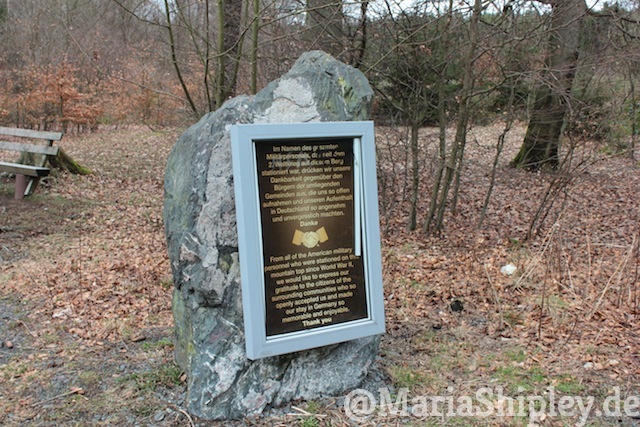
The memorial reads:
From all of the American military personnel who were stationed on this mountain top since World War II, we would like to express our gratitude to the citizens of the surrounding communities who so openly accepted us and made our stay in Germany so memorable and enjoyable. Thank you.
As part of the European Heritage Days [1](established in 1993), some memorial facilities on Camp King are open to the public in Germany on 14 September 2014 from 10am – 5pm.
This is organized by our historian, Mr Manfred Kopp, and other members of the Historical Society. Admission is free and there will be an exhibit, a guided tour, video presentations, surviving witnesses, as well as time to socialize and mingle.
Everybody is invited.

[1] European Heritage Days: Tag des Offenen Denkmals (in German)

My name is Maria Shipley. I live in Oberursel, Germany, with my husband, son and daughter. The … Read more



Copyright © 2024 · Maria Shipley · Datenschutzerklärung · Impressum · Log in
Diese Webseite verwendet Cookies. Wenn Sie auf der Seite weitersurfen, stimmen Sie der Cookie-Nutzung zu. Mehr Informationen
Diese Webseite verwendet so genannte Cookies. Sie dienen dazu, unser Angebot nutzerfreundlicher, effektiver und sicherer zu machen. Cookies sind kleine Textdateien, die auf Ihrem Rechner abgelegt werden und die Ihr Browser speichert. Die meisten der von uns verwendeten Cookies sind so genannte "Session-Cookies". Sie werden nach Ende Ihres Besuchs automatisch gelöscht. Cookies richten auf Ihrem Rechner keinen Schaden an und enthalten keine Viren. Weitere Informationen finden Sie auf der Seite “Datenschutzerklärung”.